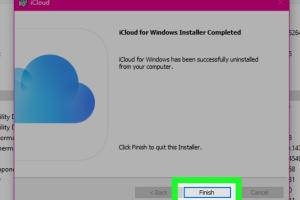Ultimate Guide to Uninstalling iCloud for Windows: Step-by-Step

-
Quick Links:
- Introduction
- Why Uninstall iCloud for Windows?
- Preparation Before Uninstalling
- Step-by-Step Uninstallation Process
- Post-Uninstallation Steps
- Common Issues During Uninstallation
- Expert Insights
- Case Studies
- Conclusion
- FAQs
Introduction
As technology advances, software applications evolve, and users often find themselves needing to uninstall programs like iCloud for Windows. This guide will provide you with a comprehensive understanding of how to uninstall iCloud from your Windows computer. Whether you're facing issues with synchronization, storage, or simply want to remove the application, we've got you covered!
Why Uninstall iCloud for Windows?
There are several reasons you might want to uninstall iCloud for Windows:
- To resolve synchronization issues with files.
- To free up disk space occupied by iCloud data.
- To install a newer version of iCloud or switch to alternative cloud services.
- To troubleshoot performance issues on your Windows machine.
Preparation Before Uninstalling
Before you begin the uninstallation process, you should take some preparatory steps to ensure a smooth experience:
- Backup Important Data: Make sure to back up any files stored in iCloud that you need to retain.
- Sign Out of iCloud: Go to the iCloud app and sign out to prevent any data loss.
- Close All Related Applications: Ensure that all applications linked to iCloud are closed.
Step-by-Step Uninstallation Process
Follow these steps to uninstall iCloud for Windows effectively:
Step 1: Access the Control Panel
1. Click on the Start Menu.
2. Type Control Panel and hit Enter.
Step 2: Navigate to Programs
1. Click on Programs.
2. Select Programs and Features.
Step 3: Find iCloud
1. Scroll through the list of installed programs.
2. Locate iCloud in the list.
Step 4: Uninstall iCloud
1. Click on iCloud.
2. Select the Uninstall button at the top of the programs list.
3. Follow the on-screen instructions to complete the uninstallation.
Step 5: Restart Your Computer
After the uninstallation process is complete, it's a good idea to restart your computer to ensure all components are removed.
Post-Uninstallation Steps
Once iCloud is uninstalled, you may want to perform the following steps:
- Check for leftover files in your Program Files directory and delete any remnants.
- Clear the cache from your Windows Registry using a reliable cleaner tool.
- Consider alternatives to iCloud if you still need cloud storage services.
Common Issues During Uninstallation
If you encounter issues while uninstalling iCloud, here are some common problems and solutions:
- iCloud Not Listed: Ensure that you have administrative privileges on your Windows account.
- Uninstallation Fails: Try using the iCloud uninstaller directly from the installation directory.
- Data Still Appears: Manually check and delete leftover files post-uninstallation.
Expert Insights
Experts recommend cleaning up your system after uninstalling any software to maintain optimal performance. Regular maintenance can prevent issues associated with leftover files and settings.
Case Studies
In a survey conducted by TechSurvey, 72% of users reported improved system performance after uninstalling unused applications, including cloud services. Users noted a significant reduction in startup time and overall responsiveness.
Conclusion
Uninstalling iCloud for Windows doesn’t have to be a daunting task. By following the steps outlined in this guide, you can efficiently remove the application and free up resources on your computer. Remember to backup any important data and consider alternative cloud services that may better suit your needs.
FAQs
Here are some frequently asked questions regarding how to uninstall iCloud for Windows:
- Q1: Can I reinstall iCloud after uninstalling it?
A1: Yes, you can always reinstall iCloud from the official Apple website. - Q2: Will uninstalling iCloud delete my data?
A2: Uninstalling iCloud will not delete your data stored on iCloud; it simply removes the application from your computer. - Q3: What if I cannot find iCloud in the Control Panel?
A3: Ensure you are logged in with an admin account and check under "Programs and Features" again. - Q4: How do I ensure all iCloud files are removed?
A4: After uninstallation, manually check the Program Files and AppData directories for leftover files. - Q5: Is there a way to uninstall iCloud using a third-party tool?
A5: Yes, many third-party uninstaller tools can help remove applications and their leftover files. - Q6: What if I face errors during uninstallation?
A6: Restart your computer and try the uninstallation process again, or use a third-party uninstaller. - Q7: Can I uninstall iCloud if I have an active subscription?
A7: Yes, your subscription remains active even if you uninstall the application. - Q8: Do I need to uninstall iCloud if I stop using it?
A8: It's not mandatory, but uninstalling can help free up system resources. - Q9: How long does the uninstallation process take?
A9: The uninstallation process typically takes a few minutes. - Q10: Will I need to restart my PC after the uninstallation?
A10: It is recommended to restart your PC to complete the uninstallation process effectively.
Random Reads
- How to share whatsapp contact
- How to share your location in waze
- How to drop a stack of items in minecraft
- Simple ways to get fragments in blox fruits
- How to find catch mewtwo pokemon heartgold soulsilver
- Take screenshots faster snipping tool shortcut
- Test webcam
- No guitar hero controller use ps2 controller
- How to fill nail holes
- How to find a stud